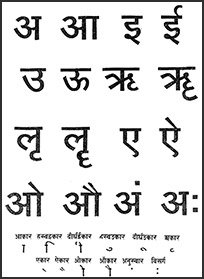Ikara, Ikāra, Īkāra: 9 definitions
Introduction:
Ikara means something in Hinduism, Sanskrit, the history of ancient India, Marathi, Hindi. If you want to know the exact meaning, history, etymology or English translation of this term then check out the descriptions on this page. Add your comment or reference to a book if you want to contribute to this summary article.
Alternative spellings of this word include Eekar.
In Hinduism
Purana and Itihasa (epic history)
Source: Cologne Digital Sanskrit Dictionaries: The Purana Index1) Ikāra (इकार).—From the third face of the fourteen faced deva came āditya, yajurmaya and yajurveda.*
- * Vāyu-purāṇa 26. 34.
2) Īkāra (ईकार).—The red coloured Manu from the fourth face of the fourteen-faced deva the originator of kṣatra.*
- * Vāyu-purāṇa 26. 35.

The Purana (पुराण, purāṇas) refers to Sanskrit literature preserving ancient India’s vast cultural history, including historical legends, religious ceremonies, various arts and sciences. The eighteen mahapuranas total over 400,000 shlokas (metrical couplets) and date to at least several centuries BCE.
Vyakarana (Sanskrit grammar)
Source: Wikisource: A dictionary of Sanskrit grammarIkāra (इकार).—The letter इ (i) with all its 18 varieties (इ (i) +कार (kāra)).

Vyakarana (व्याकरण, vyākaraṇa) refers to Sanskrit grammar and represents one of the six additional sciences (vedanga) to be studied along with the Vedas. Vyakarana concerns itself with the rules of Sanskrit grammar and linguistic analysis in order to establish the correct context of words and sentences.
India history and geography
Source: Shodhganga: Vernacular architecture of Assam with special reference to Brahmaputra ValleyIkara (in English “reed”) refers to Saccharum revennae.—It appears in the study dealing with the vernacular architecture (local building construction) of Assam whose rich tradition is backed by the numerous communities and traditional cultures.

The history of India traces the identification of countries, villages, towns and other regions of India, as well as mythology, zoology, royal dynasties, rulers, tribes, local festivities and traditions and regional languages. Ancient India enjoyed religious freedom and encourages the path of Dharma, a concept common to Buddhism, Hinduism, and Jainism.
Languages of India and abroad
Marathi-English dictionary
Source: DDSA: The Molesworth Marathi and English Dictionaryikāra (इकार).—a vulgar misspelling of vikaṇēṃ &c. Several such occur in notes &c., and for all turn to vi.
Marathi is an Indo-European language having over 70 million native speakers people in (predominantly) Maharashtra India. Marathi, like many other Indo-Aryan languages, evolved from early forms of Prakrit, which itself is a subset of Sanskrit, one of the most ancient languages of the world.
Sanskrit dictionary
Source: Cologne Digital Sanskrit Dictionaries: Cappeller Sanskrit-English DictionaryIkāra (इकार).—[masculine] the sound or letter i.
Source: Cologne Digital Sanskrit Dictionaries: Monier-Williams Sanskrit-English Dictionary1) Ikāra (इकार):—[=i-kāra] [from i] m. the letter or sound i.
2) Īkāra (ईकार):—[=ī-kāra] [from ī] m. the letter or sound ī.
[Sanskrit to German]
Sanskrit, also spelled संस्कृतम् (saṃskṛtam), is an ancient language of India commonly seen as the grandmother of the Indo-European language family (even English!). Closely allied with Prakrit and Pali, Sanskrit is more exhaustive in both grammar and terms and has the most extensive collection of literature in the world, greatly surpassing its sister-languages Greek and Latin.
Hindi dictionary
Source: DDSA: A practical Hindi-English dictionary1) Ikāra (इकार):—(nm) the vowel i ([i]) an its sound; ~[rāṃta] (a word) ending in i ([i]).
2) Īkāra (ईकार) [Also spelled eekar]:—(nm) the vowel i: ([ī]) and its sound; ~[rāṃta] a word ending in i: ([ī]).
...
Kannada-English dictionary
Source: Alar: Kannada-English corpusIkāra (ಇಕಾರ):—[noun] the letter 'ಇ'.
--- OR ---
Īkāra (ಈಕಾರ):—[noun] the letter 'ಈ'.
Kannada is a Dravidian language (as opposed to the Indo-European language family) mainly spoken in the southwestern region of India.
See also (Relevant definitions)
Starts with: Ikaramta, Ikaran, Ikarana, Ikarara, Ikarara-nama, Ikararanama, Ikararato, Ikarari, Ikararia.
Ends with (+704): A-kincit-pratikara, Abaddhaparikara, Abhikara, Abhisvikara, Abhivriddhikara, Abhyasavikara, Acchavikara, Accikara, Adhikara, Adikara, Adugulikara, Aggadikara, Agnivikara, Ahanikara, Ahikara, Aiaiaikara, Aikara, Airandhrikara, Ajirnavikara, Akhyatikara.
Relevant text
Search found 9 books and stories containing Ikara, I-kara, I-kāra, Ī-kāra, Ikāra, Īkāra; (plurals include: Ikaras, karas, kāras, Ikāras, Īkāras). You can also click to the full overview containing English textual excerpts. Below are direct links for the most relevant articles:
Shat-cakra-nirupana (the six bodily centres) (by Arthur Avalon)
Verse 39 < [Section 7]
Cidgaganacandrika (study) (by S. Mahalakshmi)
Verse 164 [Ekādaśa-varṇa] < [Chapter 3 - Third Vimarśa]
Verse 115 [Ambara Dvaya-rūpa of Śakti] < [Chapter 3 - Third Vimarśa]
Verse 141 [Pañca-devatākrama Sṛṣṭi] < [Chapter 3 - Third Vimarśa]
Vakyapadiya of Bhartrihari (by K. A. Subramania Iyer)
Verse 2.102 < [Book 2 - Vākya-kāṇḍa]
Yoga-sutras (with Bhoja’s Rajamartanda) (by Rajendralala Mitra)
Sūtra 3.49 < [Third Chapter (Vibhuti Pada)]
Vernacular architecture of Assam (by Nabajit Deka)
Samkhya thoughts in the Mahabharata (by Shini M.V.)
Ahaṃkāra (the product of Mahat) < [Chapter 2 - The Principles of Sāṃkhya Philosophy]